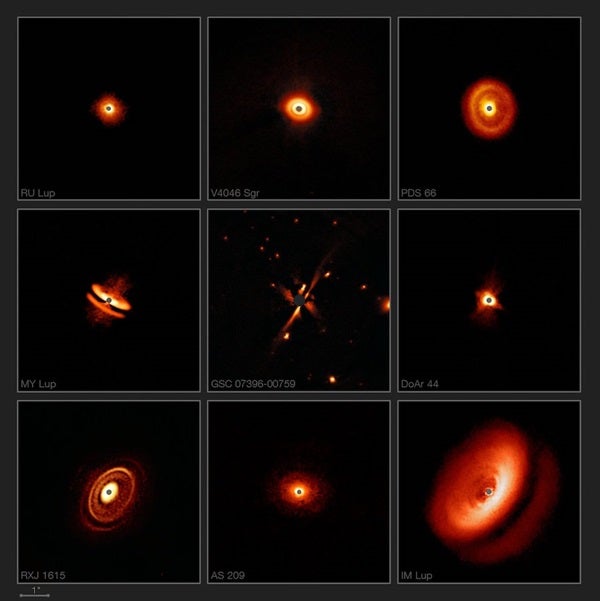ESO’s Very Large Telescope’s direct imaging instrument, SPHERE, usually spends its time surveying stars close to Earth, hoping to uncover exoplanets looming in their orbits. But recently, an international team of researchers temporarily relieved SPHERE of its planet-hunting duties to focus it on a new task: suppressing the bright light of stars to reveal the planet-forming disks that surround them.
SPHERE is an important tool for astronomers because the immense amount of light emitted by a star usually overshadows the faint light that emanates from its circumstellar disk — a circular pancake of material found around the youngest stars. This makes circumstellar disks notoriously difficult objects to study. However, by using SPHERE to drown out starlight, researchers were able to clearly image the otherwise dominated disks. The new imagery, which is a just a small sample of what was observed, reveals a veritable zoo of disks, each with their own distinct and unique features. They range in size and shape, with some extending far past their stars, while others remain close and compact. They also vary in brightness, with some disks shining much more vividly than others.
The researchers took the images during their Discs ARound T Tauri Stars with SPHERE survey (DARTTS-S), and a corresponding paper is set to appear in the Astrophysical Journal. For the survey, they focused on a class of young stars known as T Tauri stars, which have low to intermediate masses and are no more than 10 million years old. Because disks are already tough to study, they chose to focus on stars that live between 230 and 550 light-years from Earth. When considering the 100,000 light-year diameter of the Milky Way, these stars might as well be in our backyard.
These disks are made up of dust, gas, and planetesimals — precursors to the formation of planetary systems. By studying their properties, researchers can begin to correlate different types of disks with the planets that form within them.
The researchers were able to observe disks at different orientations in the sky, capturing both face-on and edge-on disks. Finding an edge-on disk is quite rare in and of itself, and the one they found circling the star GSC 07396-00759 is especially peculiar. This star was discovered during the SpHere INfrared survey for Exoplanets (SHINE) survey and is part of a multiple star system, which also houses a second T Tauri star. These two stars are the same age, classification, and orbit around a common center of mass, yet GSC 07396-00759’s disk has evolved more than the disk of its companion. Researchers are hoping to further study these kinds of anomalies to learn how two stars, that are almost identical on paper, could have disks in completely different evolutionary stages.
SPHERE’s imagery not only gives insight into the disks that surround young stars, but also helps us picture what our solar system could have looked like in its infant stage some four billion years ago. With exoplanet discoveries dominating science headlines lately, it’s important to take a step back and look at the environments in which they form, because if the dusty disks didn’t exist, we wouldn’t have anything to discover in the first place.
ESO










